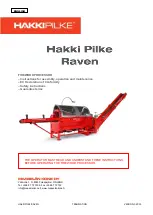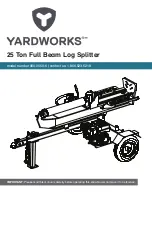
Support the tongue and pivot the jack stand up against the
3.
tongue. See Fig. 5-5.
Secure with the spring clip and clevis pin previously
4.
removed. See Fig. 5-5.
Attach the coupler hitch to a class I or higher 2” ball on the
5.
towing vehicle; latch securely.
If the coupler hitch does not fit on the ball, turn the
a.
adjustment nut one turn counter-clockwise.
If the coupler hitch is too loose on the ball, turn the
b.
adjustment nut one turn clockwise. Then recheck
and adjust accordingly.
Connect the safety chains to the towing vehicle.
6.
WARNING!
Do not tow faster than 45mph and
check the local, state and federal requirements
before towing on any public road.
NOTE:
Use caution when backing up, using a spotter outside the
vehicle is recommended.
Operating Tips
Always:
Use clean fluid and check the fluid level regularly.
1.
Use an approved hydraulic fluid. Approved fluids include
2.
Shell Tellus® 32 Hydraulic Fluid, Dexron® III / Mercon®
automatic transmission fluid, Pro-Select™ AW-32 Hydraulic
Oil or 10WAW-ISO viscosity grade 32 hydraulic oil.
NOTE:
It is not recommended that fluids be mixed.
Use a filter (clean or replace regularly).
3.
Use a breather cap on the fluid reservoir.
4.
Make sure the pump is mounted and aligned properly.
5.
Use a flexible “spider” type coupling between the engine
6.
and pump drive shafts.
Keep the hoses clear and unblocked.
7.
Bleed the air out of the hoses before operating.
8.
Flush and clean the hydraulic system before restarting after
9.
servicing.
Use “pipe dope” on all hydraulic fittings.
10.
Allow time for the engine to warm-up before splitting the
11.
wood.
Prime the pump before the initial start-up by turning over
12.
the engine with the spark plug disconnected (if not already
done at the factory).
Split the wood along the grain (lengthwise) only.
13.
Never:
Use when the fluid is below 20° F or above 150° F.
1.
Use a solid engine/pump coupling.
2.
Operate through the relief valve for more than five
3.
seconds.
Attempt to adjust the unloading or relief valve settings
4.
without pressure gauges.
Operate with air in the hydraulic system.
5.
Use Teflon tape on the hydraulic fittings.
6.
Attempt to cut wood across the grain.
7.
Attempt to remove partially split wood from the wedge
8.
with your hands. Fully retract the wedge to dislodge the
wood with the log dislodger.
Spring Clip
Clevis Pin
Jack Stand
Figure 5-5
13
s
ectiOn
5 — O
peratiOn
Summary of Contents for LS 27 TB
Page 17: ...Notes 17...
Page 22: ...22 This page was intentionally left blank...
Page 23: ...Notes 9 23...
Page 43: ......







































